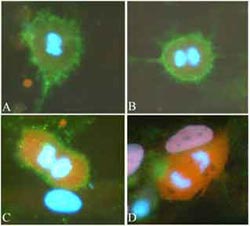Patient-specific stem cell lines – now a real possibility

Mitosis in human embryonic stem (hES) cell cytoplast cybrid following fusion. A, B, C, D: Increasing appearance in background of red fluorescence [octamer binding transcription factor-4 (Oct-4)] surrounded by ring of green fluorescence [tumour rejection antigen-2-39 (TRA-2-39)], with no nucleoli being present. Blue fluorescence: DAPI, showing the chromosome location. Original magnification x40.
Immune rejection problems could affect any one of us. This unique research shows that producing individual patient cell lines for our own future needs is now something we might all want to consider.
Somatic cell nuclear transfer (SCNT) forms the basis for obtaining patient specific stem cells and with the presence of reprogramming factors in human embryonic stem (hES) cells, a method for replacing the nuclei of hES cells by somatic cell nuclei has been widely sought.
Nick Strelchenko et al. based at the Reproductive Genetics Institute in Chicago, USA, has now developed an original technique resulting in the first evidence of the complete replacement of the nuclei of hES cells by nuclei of somatic cells. Their paper Reprogramming of human somatic cells by embryonic stem cell cytoplast is accepted and was published online by Reproductive BioMedicine Online, www.rbmonline.com/Article/2071 on 18 November 2005. The final article will also be published in print in the January 2006 issue of the journal.
The new technique involves the fusion of different types of somatic cells with hES cells. The resulting ‘cybrids’ were shown to have the genotype of the donor somatic cells and the ‘stemness’ (the ability of the cells to divide, change throughout our lifetime, to provide cells that can become specialised and to replace those that die or are lost) of the recipient hES cells.
Nuclear reprogramming of somatic cells has been performed by fusion with ES cells, (Tada et al., 1997, 2001; Cowan et al., 2005). However, the resulting hybrid cells contained the nuclei of both somatic and hES cells (Cowan et al., 2005). This was due to the fact that the hES cells were not enucleated.
A key factor in this new research is that the hES cells were enucleated prior to their cytoplasts fusing with the somatic cell nuclei (Fig 1). Cell division then resulted in the establishment of cybrid cells (Fig 2) with typical hES cell morphology and ‘stemness’ shown by the presence of Oct -4 and TRA-2-39 confirming the replacement of the hES cell nuclei by the nuclei of somatic cells.
10-40 colonies were produced following 1-week culture of the resulting hybrid cells. These colonies contained cells with different karyotypes including the 46XY cybrid cells, representing a complete replacement of hES cell nuclei of donor somatic cells as well as 46,XXY and 92,XXYY cells representing hybrids between the donor and non-enucleated hES-cells. Fig 3 shows that the hES cell markers were positive in cybrid colonies which were cultured for many passages.
Whilst there still remains the problem of how to isolate the pure population of hES cell cybrid colonies and the extent to which the hES cell cybrids can be reprogrammed still needs to be determined, this research provides scientists with a new method of investigation and brings our ability to harness the therapeutic value of our own genetically identical stem cells significantly closer.
Media Contact
All latest news from the category: Life Sciences and Chemistry
Articles and reports from the Life Sciences and chemistry area deal with applied and basic research into modern biology, chemistry and human medicine.
Valuable information can be found on a range of life sciences fields including bacteriology, biochemistry, bionics, bioinformatics, biophysics, biotechnology, genetics, geobotany, human biology, marine biology, microbiology, molecular biology, cellular biology, zoology, bioinorganic chemistry, microchemistry and environmental chemistry.
Newest articles

NASA: Mystery of life’s handedness deepens
The mystery of why life uses molecules with specific orientations has deepened with a NASA-funded discovery that RNA — a key molecule thought to have potentially held the instructions for…

What are the effects of historic lithium mining on water quality?
Study reveals low levels of common contaminants but high levels of other elements in waters associated with an abandoned lithium mine. Lithium ore and mining waste from a historic lithium…

Quantum-inspired design boosts efficiency of heat-to-electricity conversion
Rice engineers take unconventional route to improving thermophotovoltaic systems. Researchers at Rice University have found a new way to improve a key element of thermophotovoltaic (TPV) systems, which convert heat…



